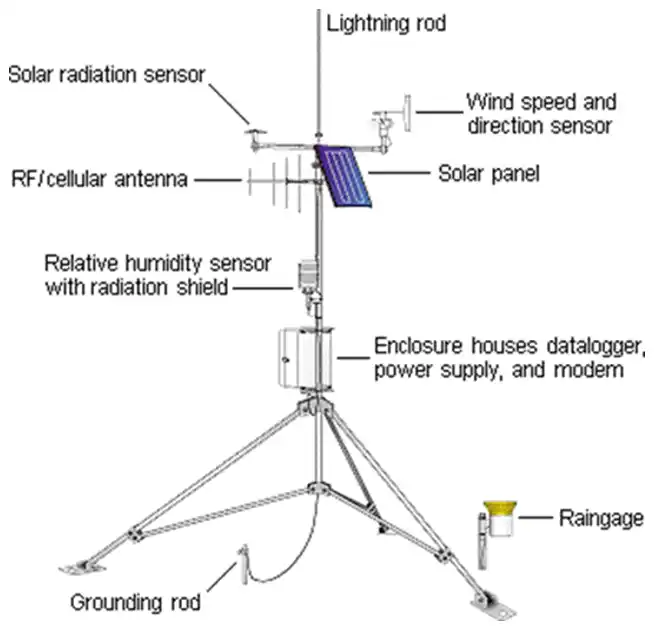Precision agriculture, also known as smart farming, involves utilizing connected devices and sensors to remotely collect data and supervise agricultural activities. The utilization of various devices and sensors is common in enhancing agricultural monitoring:
Weather Stations: Devices like weather stations monitor essential parameters like temperature, humidity, wind speed, and aiding farmers in decision-making related to irrigation, planting, and harvesting.
Soil Sensors: These devices play a crucial role in providing real data on soil conditions, moisture content, pH levels, and nutrient levels. This data assists in optimizing irrigation schedules and fertilization practices.
Crop Monitoring Cameras: Advanced cameras capture images of crops to assess growth, detect diseases, and monitor crop health in real-time, contributing significantly to remote monitoring in agriculture.
GPS Technology: GPS-enabled devices such as tractors and drones help track field activities, map fields, and optimize routes for farming tasks, ensuring precision in positioning and navigation.
Drones: Equipped with cameras and sensors, drones offer real-time aerial imagery that helps farmers detect crop stress, monitor plant health, and identify areas requiring attention.
Livestock Monitoring Systems: Sensors are used in livestock farming to track animal health, behaviour, and location, aiding farmers in managing herd health and enhancing feeding and breeding practices.
Irrigation Controllers: These devices automate irrigation systems based on data from weather stations and soil sensors, ensuring efficient water use and optimal crop growth. By integrating a combination of these devices and sensors, farmers can effectively monitor their operations, enhance productivity, optimize resource utilization, and reduce costs. Embracing these technologies not only enhances crop and livestock management but also contributes to achieving sustainability in agriculture for future generations.

Soil sensors are like little detectives in the ground, checking moisture, pH, and nutrients in the soil. This info is super helpful farmers to water their crops just right and them the nutrients they need. sensors are like the secret agents of farming, giving important data on soil health that helps crops grow better and resources get used smarter.
Here’s how soil sensors help with keeping an eye on things in farming Cameras for watching over crops take pictures regularly to see how they’re growing, catch any diseases early, and check if they’re healthy. Fancy technology in these cameras can spot specific problems using smart image analysis. These cameras are like the superheroes of tools, showing real-time images that tell farmers how their crops are doing and if there are any issues popping up. Here’s how crop monitoring cameras help with keeping an eye on things in farming.
GPS gadgets, like the ones in tractors and drones, help farmers keep track of what’s going on in their fields, make maps of where things are growing, and plan out the best routes for planting, spraying, and harvesting. GPS tech is super important for modern farming since it helps with getting things exactly where they need to be for different farm jobs. Here’s how GPS technology helps with keeping an eye on things in farming.
Drones fly high above fields with cameras and sensors to give a bird’s eye view of what’s happening below. This info helps farmers see if their crops are stressed out, check on plant health, and spot areas that need some extra care. Livestock monitoring systems are super helpful for farmers. They use sensors to track the health, behaviour, and location of animals. This data helps farmers take care of their herds and improve how they feed and breed them. Irrigation controllers are another cool invention. They automatically control irrigation systems with data from weather stations and soil sensors. This makes sure that water is used efficiently for the best crop growth.
Crop yield monitors are awesome too! They’re put on harvesters to measure crop yield and quality. Farmers can use this info to see how well their fields are doing and make plans the next seasons.
Remote access systems let farmers watch over their operations from afar. They can control things using smartphones, tablets, or computers. These systems give farmers access to sensor and device data so they can make fast decisions. Wireless Sensor Networks (WSNs) are a bunch of sensors spread out across the farm. They collect data on environmental conditions, crop status, and equipment performance. The sensors talk wirelessly to a main system for analysis and decision-making help.
By using these gadgets together, farmers can keep a close eye on their farm work, save resources, boost productivity, and cut down on costs. Plus, they can look at trends over time to make better choices and improve how they run things on the farm.
Overall, these smart devices and sensors are changing farming for the better. They give farmers the tools they need to run things well, handle crops and animals with care, and be more eco-friendly. Getting into these high-tech tools helps farmers deal with today’s challenges in agriculture so we can have enough food in the future without harming the environment!
– Dr. Rajasekar Rangasamy, Professor
– Dr R C Karpagalakshmi, Professor
– Dr.Linen, Professor and Head -Computer Applications
– Dr.Pavithra. K, Assistant Professor
Department of Computer Science and Engineering, Alliance University
